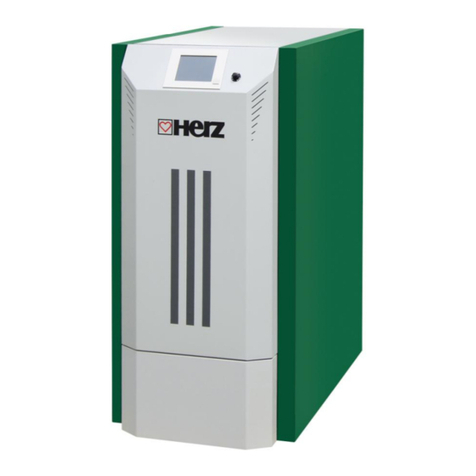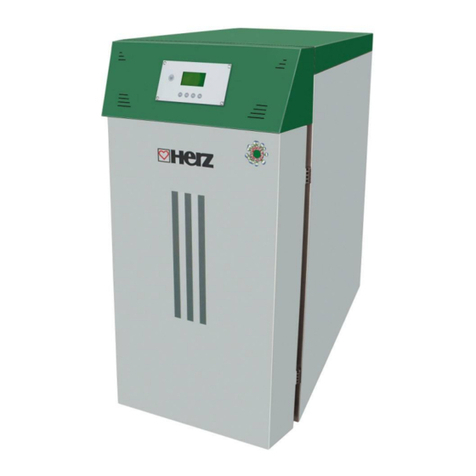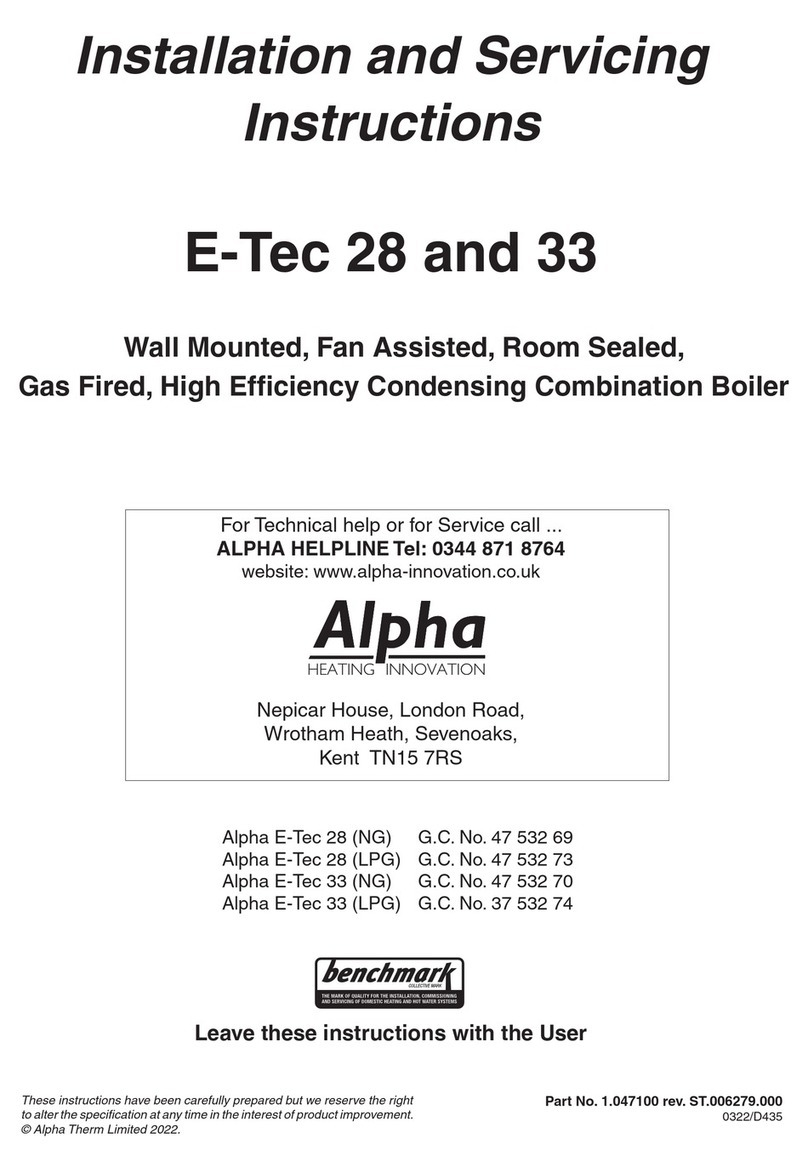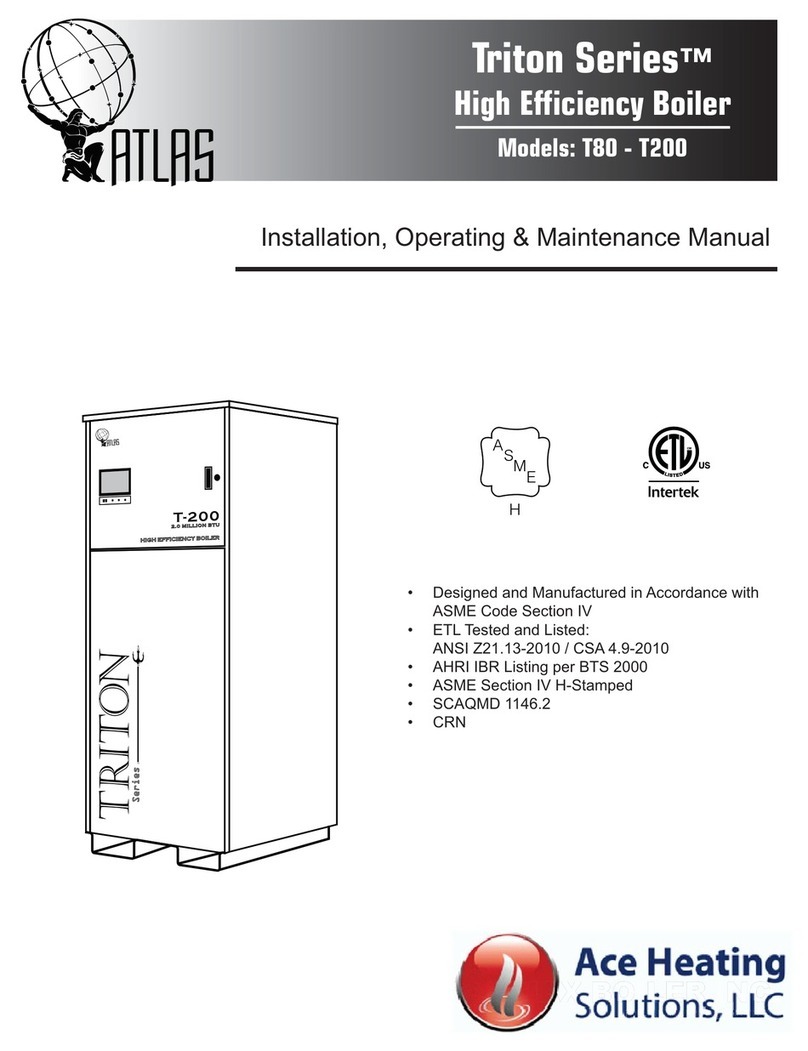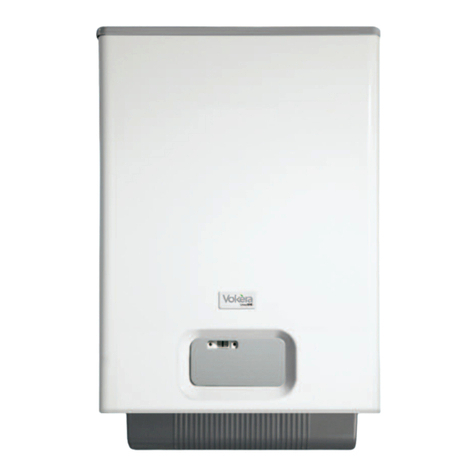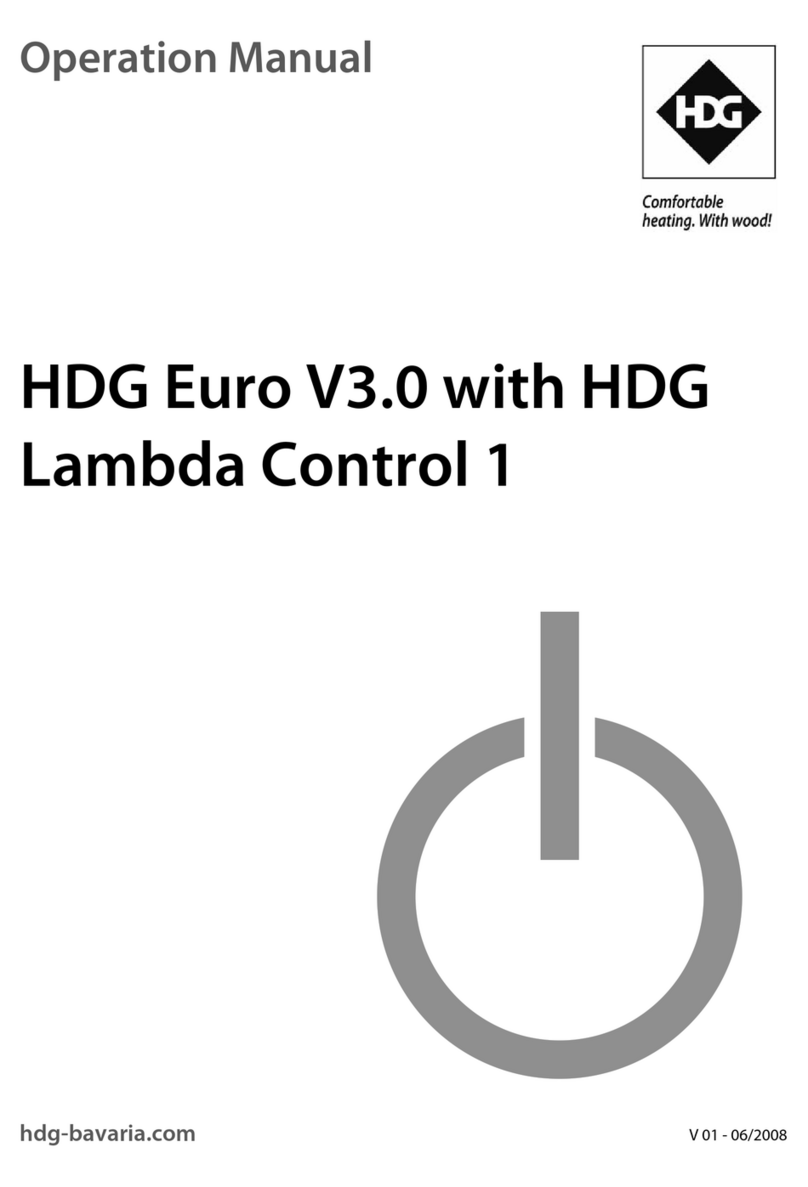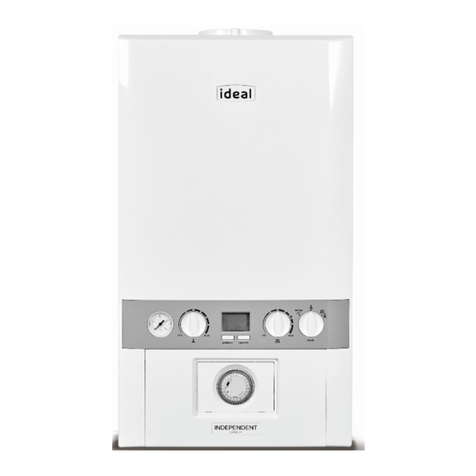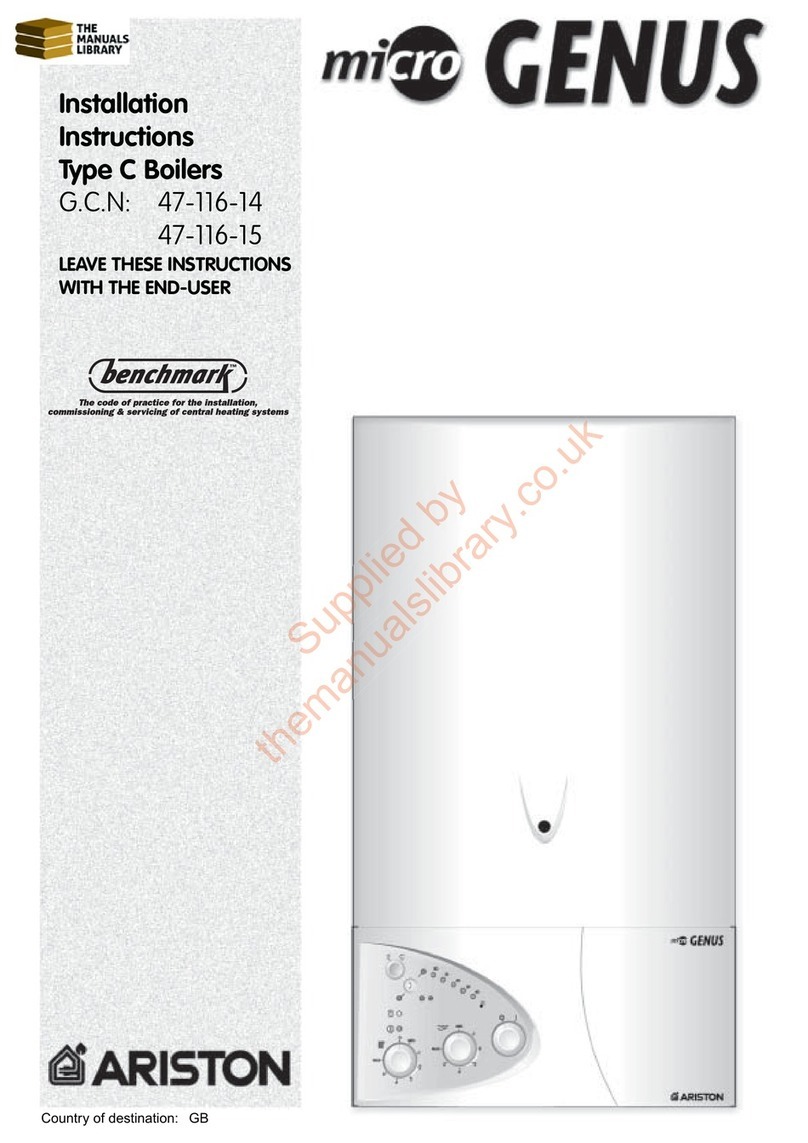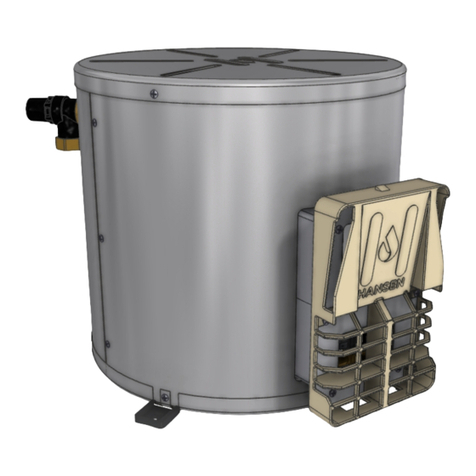Herz firestar de Luxe 18 User manual

OPERATING INSTRUCTIONS
Log wood boiler
firestar de Luxe
18-40

Introduction
2 Betriebsanleitung_firestar 18-40_T-CONTROL_2_eng_V1.0
INTRODUCTION
Dear Customer!
Your heating equipment is powered using HERZ firestar boiler equipment and we are delighted to be able to
welcome you into the large circle of satisfied operators of HERZ equipment. The HERZ boiler is the result of
years of experience and continuous improvement. Please remember that in order to be able to work
properly, a well-designed product also needs to be operated and maintained correctly. Please therefore read
this documentation carefully –you will find it worthwhile. Please pay particular attention to the safety notes. It
is a precondition of any warranty claim that all operating rules are maintained. In the event of any faults or
defects, please contact your heating specialist or the HERZ Customer Service department.
Yours sincerely
HERZ –Energietechnik
Warranty / Guarantee (general information)
HERZ boiler systems come with a 5-year warranty on the boiler body, storage tanks and HERZ solar
collectors. We generally guarantee freedom from defects of mobile objects purchased for a period of 2 years,
to a maximum of 6.000 hours of operation. For non-moving purchased items, the guarantee is generally for a
period of 3 years to a maximum for 9.000 hours of operation. Wearing parts are not covered by the
guarantee/warranty. Furthermore, claims under warranty will not be applicable if there is no return flow
temperature boost or it is not working properly, if commissioning
1
is not carried out by specialist personnel
authorised by HERZ, in the case of operation without a buffer storage tank with a heating load of less than
70% of the rated output (manually stoked boilers must always be operated with a sufficiently dimensioned
buffer storage tank), if hydraulic diagrams
2
not recommended by HERZ are used and if a non-prescribed fuel
as well as pellets for non-industrial use according to ENplus, Swisspellet, DINplus resp. EN 17225-2; wood
chips according to EN 17225-1/4 with specification and classes: A1, A2, B1 resp. G30, G50 resp. log wood is
used
3
.
All business is subject to the general terms and conditions of HERZ Energietechnik GmbH as well as the
agreements confirmed with the order acceptance.
These are available at www.herz-energie.at .
Any claim to warranty services requires maintenance to be carried out on an annual basis by
specialist personnel authorised by HERZ.
Guarantee work does not affect any extension of the general term of guarantee. A guarantee claim does not
delay the due date of our accounts. We will only provide a guarantee if all the payments owed to us for the
product supplied have been made.
The warranty will be carried out at our discretion by repairing the item purchased or replacing any defective
parts, by exchanging the item or by reducing the price. Parts or goods replaced are to be returned to us at
our request free of charge. Wages and costs paid out in connection with installation and removal are to be
paid for by the purchaser. The same applies to all warranty services.
The Supplier shall under no circumstances be liable to the Customer, for any direct, indirect or consequential
costs incurred by the Customer for works carried out on HERZ equipment.
This document is the translation from the German original. The reproduction or copying, even of extracts,
may only be undertaken with the permission of the company HERZ©.
Subject to technical modifications.
Version 03/2022
1
Maintenance by manufacturer
2
Recommended hydraulic diagrams can be found in the installation manual, while hydraulic balancing will be carried out by the heating
contractor
3
Furthermore, the quality of the heating water must be in accordance with ÖNORM H 5195 (current version) or VDI 2035

Table of content
3
TABLE OF CONTENT
Page
page
1SAFETY NOTES.......................................4
2WARNING NOTES ...................................5
2.1 Installation.......................................................5
2.2 Operation and maintenance...........................5
2.2.1 General safety notes.........................................5
2.2.2 Operation..........................................................6
2.2.3 Maintenance.....................................................6
3FUELS....................................................... 7
3.1 Log wood.........................................................7
3.2 Suitable fuels ..................................................7
3.3 Not suitable fuels............................................7
4HANDLING OF THE HEATING SYSTEM 8
4.1 Sealing the boiler............................................8
4.2 Operation with low performance decrease...8
4.3 Overheating of the boiler-STL .......................8
4.4 Sweating of the boiler ....................................8
4.5 Cold system start up ......................................8
4.6 Decommissioning...........................................8
5BOILER OPERATION .............................. 9
5.1 Preparation for heating up with log wood....9
5.2 Heating up.......................................................9
5.2.1 Boiler with automatic ignition ..........................10
6SYSTEM..................................................11
6.1 Re-heating.....................................................12
6.2 FAULT-FREE OPERATION...........................12
7OPERATING CONDITIONS ...................13
7.1 Boiler operation with log wood ...................13
8TEMPERATURE MANAGER .................15
9BOILER CONTROL................................ 19
9.1 Lambda control (inside)...............................19
9.1.1 Display............................................................19
9.2 T-CONTROL (outside) ..................................20
9.3 Starting the system ......................................20
9.3.1 Operation and handling ..................................21
9.4 Main menu.....................................................21
9.5 Symbols explanation....................................22
9.6 Code –entry..................................................23
9.7 Switching the boiler on and off (chimney
sweeping function).......................................24
9.8 Date and time................................................25
9.9 Main menu values.........................................26
9.9.1 Adding / defining display values......................26
9.9.2 Delete values..................................................27
9.10 Fault messages and warnings.....................28
9.11 Module...........................................................29
9.12 Module configuration ...................................30
9.13 Terms and definitions ..................................30
9.13.1 Boiler ..............................................................31
9.13.2 Buffer..............................................................34
9.13.3 Hot water tank.................................................36
9.13.4 Heating circuit.................................................38
9.13.5 Time mode......................................................43
9.13.6 Solar................................................................44
9.13.7 Hydraulic compensator ...................................46
9.13.8 Net pump ........................................................47
9.13.9 Zone valve ......................................................48
9.13.10 External requirement.......................................50
9.13.11 Additional boiler ..............................................53
9.14 System settings.............................................55
9.14.1 Network configuration .....................................56
9.14.2 Modbus –settings...........................................57
9.14.3 Screensaver....................................................58
9.14.4 Remote ...........................................................58
9.14.5 Information overview.......................................59
9.14.6 Sending E-mails..............................................59
9.14.7 Mail Server settings.........................................61
9.14.8 E-Mail status report.........................................61
9.14.9 Service special................................................62
9.14.10 Cascade..........................................................62
10 FAULT REPORTS AND THEIR
CORRECTIONS ......................................63
10.1 Not indicated faults.......................................70
11 MAINTENANCE SCHEDULE .................70
11.1 Weekly Inspection.........................................70
11.2 Monthly inspection, at least every 1000
operating hours.............................................72
11.3 Annually inspection......................................75
11.4 As needed......................................................75
12 EU DECLARATION OF CONFORMITY.76
13 ACCORDING TO EU REGULATION
2015/1189................................................77
14 ACCORDING TO EU REGULATION
2015/1189................................................78
14.1 Correct disposal of this product..................78
15 INDEX DIRECTORY................................79
16 ANNEX ....................................................80
16.1 Additional boiler module..............................80
16.2 Solar module .................................................82
17 NOTES ....................................................88

1
Safety notes
4
1 SAFETY NOTES
◼Before commissioning, please read the documentation carefully and pay attention to the safety
instructions given in particular. Please consult this manual if anything is unclear.
◼Make sure that you understand the instructions contained in this manual and that you are sufficiently
informed regarding the way in which the biomass boiler system works. Should you have any queries
at any time, please do not hesitate to contact HERZ.
◼For safety reasons, the owner of the system must not make any changes to the construction or the
state of the system without consulting the manufacturer or his authorised representative.
◼Make sure that there is a sufficient supply of fresh air to the boiler room (please heed the relevant
national regulations).
◼All connections are to be checked before the commissioning of the system in order to make sure that
they are leak-tight. Check all screw connections for strength.
◼A portable fire-extinguisher of the prescribed size is to be kept by the boiler room. (Please heed the
relevant national regulations).
◼When opening the door to the combustion chamber, make sure that no flue gas or sparks escape.
Never leave the combustion chamber door open unattended as toxic gases may escape.
◼Never heat the boiler using liquid fuels such as petrol or similar.
◼Carry out maintenance regularly (in accordance with the maintenance schedule) or use our
Customer Service department.
◼When carrying out maintenance on the system or opening the control unit, the power supply is to be
disconnected and the generally valid safety regulations are to be heeded.
◼In the boiler room, no fuels may be stored outside the system. It is also not permitted for objects
which are not required for the purpose of operating or carrying out maintenance on the system to be
kept in the boiler room.
◼When filling the fuel bunker using a pump truck, the boiler must always be switched off. (this is
stamped on the cover of the filling connection). If this instruction is not heeded, flammable and toxic
gases may get into the storage room!
◼The fuel bunker is to be protected against unauthorised access.
◼Always disconnect the power supply if you need to enter the fuel bunker.
◼Always use low-voltage lamps in the storage room (these must be approved for this type of use by
the relevant manufacturer).
◼The system is only to be operated using the types of fuel prescribed.
◼Before the ash is transported further, it must be stored temporarily for at least 96 hours in order to let
it cool down.
◼Should you have any queries, please call us.
◼Initial commissioning must be carried out by the Customer Service department or an authorised
specialist (otherwise any warranty claim will not be applicable).
◼Ventilate fuel storage room for ~ 60 minutes before trespassing /Please refer to the respective
country regulations).
◼The boiler meets the requirements of the Association of Swiss Canton Fire Insurance Companies or
national fire safety regulations. The customer himself shall be responsible without exception for
ensuring that these regulations are complied with on site!

Warning notes
2
5
2 WARNING NOTES
Risk of injury and damage to
property due to improper
handling of the system. Damage
to property is possible.
Caution –hot surface
Warning –against hand injuries.
No admittance without
authorisation.
However, adherence to guidelines for
transportation, installation, operation and
maintenance notices as well as technical data (in
the operating instructions, product documentation
and on the equipment itself) which are not
specifically highlighted, is also vital to avoid
breakdowns which may directly or indirectly cause
major personal or material damage.
General safety notes
For reasons of clarity and possible permutations,
this documentation does not contain all detailed
information and cannot take account of every
conceivable operating or maintenance scenario.
Should you require further information or
encounter specific problems, which are not
handled in detail in the documentation supplied,
you can obtain the required information from your
specialist dealer or direct from HERZ.
People (including children) who, because of their
physical, sensory or mental capabilities or
because of their lack of experience or knowledge,
are unable to use the equipment safely must not
use this equipment unless they are supervised or
instructed by a responsible person.
Basic safety information
Due to its functionally limited electrical and
mechanical characteristics with regard to usage,
operation and maintenance, if the equipment is
not able to work according to its appropriate use
or improper interference occurs, it may cause
serious health and material damage. It is therefore
conditional that the planning and implementation
of all installations, transportation, operation and
maintenance will be carried out and supervised by
responsible, qualified persons.
When operating electrical systems, certain parts
of those systems will always carry a hazardous
electrical voltage or be exposed to a mechanical
load. Only appropriately qualified personnel may
carry out work on the system. They must be
thoroughly familiar with the content of this and all
other manuals. In order for this system to function
safely and without any problems, transportation,
storage, operation and maintenance must be
carried out properly and carefully. Instructions and
information on the systems must also be heeded.
2.1 Installation
General safety notes
In order to ensure that the system will function
properly, the relevant standards and the
manufacturer’s installation instructions are to be
heeded during the installation of the system!
Documents from the manufacturer relating to the
heating devices and components used are
available from HERZ on request.
2.2 Operation and maintenance
2.2.1 General safety notes
In order for the system to be
operated and maintained safely, it
must be operated and maintained
properly by qualified personnel
while heeding the warnings in this
documentation and the
instructions on the systems.
In unfavourable operating
conditions, the temperatures of
parts of the housing may exceed
80 °C.
Ambient conditions
Operating temperature:
+10 to +40 °C
Warehouse-/ transport
temperature:
-20 to +70 °C
Humidity:
operation
5 to 85 %
storage
5 to 95 %

2
Warning notes
6
2.2.2 Operation
General safety instructions
Covers which prevent contact
with hot or rotating parts or which
are required in order to direct the
flow of air correctly and thus
ensure the effective functioning of
the system must not be opened
during operation.
In the event of a fault or unusual
operating conditions such as the
emission of smoke or flames, the
system is to be switched off
immediately by operating the
emergency stop button. Notify the
HERZ Customer Service
department immediately.
◼If the boiler room door main switch is
operated or if a power failure occurs, the
system will be taken out of operation
immediately. The remaining quantity of
residual fuel will burn independently
without giving off any toxic gases provided
that the chimney draught is sufficiently
high. Therefore, the chimney must be
designed and produced in accordance
with DIN 18160 or EN 13384. When the
boiler is switched on again, the system
has to be checked in order to make sure
that it is fully functional and a safe
operation of the whole system must be
guaranteed!
◼If the residual flue gas oxygen content
drops below the required minimum of 5
%, the fuel supply will be stopped
automatically and will not be activated
again until the residual oxygen content
has risen to more than 5 % (fault text:
MIN O2 [%] 5.0, see chapter boiler Status
IV)
◼The generated system noise during
operation does not present any danger to
the operator´s health.
2.2.3 Maintenance
General safety measures
Before starting to carry out any work on the
system, but especially before opening covers
protecting live parts, the system is to be properly
disconnected from the power supply. Besides the
main circuits, attention is also to be paid to any
existing additional or auxiliary circuits in the
process. The normal safety rules according to
ÖNORM are:
◼Disconnect all poles and all sides!
◼Ensure that the system cannot be
switched on again!
◼Check to ensure that no voltage is
connected!
◼Earth and short-circuit!
◼Cover adjacent live parts and locate
hazardous areas
These above-mentioned
measures must not be reversed
until the system has been fully
installed and maintenance has
been completed.
Personal dust masks and gloves
must be worn when carrying out
maintenance in the combustion
chamber or the ash collector or on
flue gas-carrying parts and when
emptying the ash container, etc.!
Extra-low-voltage lamps are to be
used when carrying out
maintenance work in the storage
room. Electrical equipment in the
storage room must be designed in
accordance with
ÖNORM_EN_ISO_20023!
In order to prevent any maintenance errors, if
maintenance is not carried out properly, it is
recommended to be carried out regularly by
authorised personnel or by the HERZ Customer
Service department.
Spare parts must be obtained directly from the
manufacturer or a distribution partner. The
customer will not be exposed to any health risks
as a result of the noise generated by the machine.

Fuels
3
7
3 FUELS
The HERZ firestar boiler should be operated with
the fuels and their properties which are described
in this chapter.
3.1 Log wood
The HERZ –firestar is suitable for burning logs to
operate central heating systems for closed hot
water installations. Smaller split logs enable
higher boiler performance than whole ones. We
recommend triangular firewood with side lengths
of 50 cm and edge lengths of 8 cm. Too coarse or
too long firewood may lead to reduced
performance and hollow fire. The heat value of the
wood is primarily dependent on its moisture
content. The heat value decreases with increased
moisture. The combustion of wood with high
moisture content also causes a decrease in the
degree of efficiency of the boiler.
Wood should therefore be stored for at least two
years in a dry, ventilated place. Oak needs to be
stored for about a year longer. Dry bark displays a
heat value similar to wood but there is more likely
to be increased formation of ash.
The burning of unsuitable fuels could lead to
uncontrolled combustion. The guarantee becomes
invalid! Operational faults and consequential
damage are likely to occur.
Possible consequential damage:
◼Damage to the thermodynamic combustion
chamber, the lambda probe, the flue gas
probe due to aggressive residues in the
boiler
◼Sooting or corrosion in the filling area due to
condensation as a result of using fuel that is
too moist.
◼The escape of flue gas from the airflow
apertures through uncontrolled combustion
(deflagrations).
◼Combustion time at nominal load up to
Combustion time in hours
Type
FS 18
FS 20
FS 30
FS 40
Softwood
5
6,5
6
3,5
Hardwood
6
8
7
4,5
Wood
chips
3
4
3,5
2,5
3.2 Suitable fuels
The firewood must be air dried, that is, dried at
least one year with water content below 20 %
preferable half-meter logs with an average
diameter of 10 cm. If the cleavage planes of the
log wood are much larger, the log wood should be
thinner, in extreme cases 20 to 5 cm.
Small sized material may be burned only as
admixture. From the smaller material may be
added less. Wood briquette with 6 to 10 cm
diameter according EN 17225-3.
Only one oversized log each boiler filling
To split a root stock to such thin pieces is very
hard work. Per boiler filling maximum one large
root stock piece are burned up in the stack.
Type of
wood
Calorific values (by wood
moisture 25%) in kWh/stere
Beech
1890
Oak
1930
Pine
1520
Spruce
1330
We recommend to use beech
wood. Do not mix different types
of wood. The use of one type of
wood promotes a consistent
burn-off and reduces burning
disturbance. However, if it cannot
be avoided to use different types
of wood, the boiler must be filled
in layers (softwood below,
hardwood above).
3.3 Not suitable fuels
When burning wet fuel with more than 30% water
content, condensation water formation and
corrosion on the walls of the filling chamber occur.

4
Handling of the heating system
8
Furthermore, should not be burned:
Garbage, plastics, paper and cardboard (only for
starting the fire), sanding dust, wood shavings,
wood chips smaller than thumb-size, coal and
coke, the respective Clean Air Act (state law)
usually prohibited fuels such as old railroad ties,
plastics, particle board, impregnated wood.
4 HANDLING OF THE
HEATING SYSTEM
4.1 Sealing the boiler
It is imperative that all doors are closed during
operation so that no leak air can disrupt the
combustion process. If this is not observed then
damage to the boiler may result.
4.2 Operation with low
performance decrease
Should fuel be burned in the transition period
(spring or autumn) it is vital to ensure that for low
decreased performance (less than 50%) the filling
shaft is not completely put on. Decreased
performance of less than 50 % means the boiler
and the chimney may become clogged with soot.
It is also possible that smoke may develop in the
chimney. The firestar boiler should there for
basically be operated equipped with a correctly
dimensioned buffer (according to EN 303-5).
Recommended dimensions are listed in the
document “installation instructions".
4.3 Overheating of the boiler-STL
Should the boiler temperature exceed maximum
boiler temperature, the safety temperature limiter
switches the controls off. After the equipment has
cooled off under about 75°C, the Safety-
Temperature Limiter (STL) should be tripped by
unscrewing the covering cap (press the button).
Afterwards screw up the covering cap again.
Before re-starting the cause of the overheating
should be identified and corrected.
Thermal valve for security heat exchanger
If the boiler overheats then the “thermal safety
device” opens automatically (at 95°C) via a sensor
and cold water flows through the heat exchanger.
The boiler water is thereby cooled off and
dangerous operating conditions are prevented.
The water heated up in the heat exchanger must
be able to run away freely (directly into the waste
water channel). After the boiler water has cooled
off about 90 °C the "thermal safety device”
automatically interrupts the cold water feed. After
cooling off the equipment pressure and/or water
level of the equipment is to be controlled and if
necessary the missing amount of water topped
up. According to DIN 4751 sheet 2 the operator is
obliged to regulate the functioning of the “thermal
safety device” and the heat exchanger belonging
to it at least once a month by activating the test
button. Furthermore, this safety instruction is to be
monitored once a year by the manufacturing
company or another competent organisation.
Attention:
If it is a inoperable combination of the “thermal
safety device” and heat exchanger, the set-up of
the equipment is prohibited!!
4.4 Sweating of the boiler
During long-term operation it should be
guaranteed that the return flow temperature does
not fall below 65 °C. For this reason a return flow
temperature bypass is obligatory.
Attention:
Corrosion damages which are caused by too low
return flow temperatures do not come under the
guarantee or warranty.
4.5 Cold system start up
After a long period of not being used, you should
take particular note of the following points when
starting up the system:
◼Where the equipment has cooled down, the
boiler requires a proportionate amount of
time to reach temperature if all heat
consumers are switched on during the
heating up process. Therefore, firstly put only
one small heating circuit into operation and
switch the other heating circuits only on when
the boiler has reached its operating
temperature. The first start-up should only be
carried out by HERZ factory customer service
or persons authorised as such.
4.6 Decommissioning
The main switch should not be turned “OFF”
during the burn-off only after complete burn-off.
(Status: Heating off)

Boiler operation
5
9
5 BOILER OPERATION
5.1 Preparation for heating up
with log wood
If possible, store enough fuel for two or three
combustion processes near the boiler room.
Prepare firewood
The firewood must correspond to size
(circumference 8 –10 cm) and dimensions to the
size of the boiler. Firewood without bark burns
better.
5.2 Heating up
Warning: Risk of system damage
due to improper maintenance!
Wrong position or lack of
firebricks inside the boiler can
lead to damage or destruction of
the boiler.
◼Before heating up the boiler,
check the position of the
firebricks.
Warning: Risk of system damage
due to improper maintenance!
Excessive fuel feeding can cause
overheating and damage to the
boiler.
◼Adapt the amount of fuel to
the energy absorption
capacity of the heating
system.
Crucial for the clean burn-off in
the boiler are the correct
operation of the boiler as well as
a sufficient feed pressure of the
exhaust system.
When heating up with log wood
there may occur a greater smoke
production at the chimney.
In the following a possibility for the heating up of
the boiler is described. Depending on the ambient
conditions (draft, exhaust system, wood, and so
on) other heating up processes may be better.
Get conversant with the boiler and find out the
best handling to use. Test the best opportunity for
heating up the boiler.
Please note always the safety notes!
◼Switch on the main switch [2] and regulator
(→On/Off –button, page).The regulator
displays status 1.
1 … Cable bushing
2 ... Main switch
3 … Electric supply
◼After the casing door is opened the “burning”
phase (Status: 2) starts automatically.
If it is not desired or necessary to
heat up the boiler, this process
can be interrupted with a long
press of the On/Off button.
◼To form a good flame it is recommended that
the lower third of the filling shaft be filled with
small pieces of wood.
◼After that normally chopped wood (size
around 8 cm) can be used for filling.
◼Then close filling door and open the firing
door (4) and fire up with an oil ignition, wood
shavings or cardboard.
◼When the flue gas temperature is 120°C,
close all doors.
By sufficient feed pressure a fire bed (chimney
flue) is built up and the wood in the filling room is
burning from bottom to top.

5
Boiler operation
10
Too short and thick wood logs
lead to an uneven burning
behaviour. Too short and thin
wood reduces the burning time.
→Only use wood logs according
to specification
It is imperative that all doors are
closed during operation so that
no leak air can disrupt the
combustion process.
The heating-up time can change
due to the cleaning condition of
the boiler, the local conditions,
the used fuels and the weather
changes (low pressure in the
exhaust system).
The boiler operates according to the principle of
the lower burn-up. The control device controls the
boiler automatically and completely.
5.2.1 Boiler with automatic ignition
Before filling with logs, the openings of the ignition
elements must be checked for contamination and,
if necessary, cleaned.
When filling with log wood, it should be noted that
in the area of the ignition elements in the heating
door is also small split wood. When closing the
heating door, the piece of wood must be press
end against the door.
So that the automatic ignition will be activated, the
system must be started manually via the controller
- the boiler "Wait" appears.
The system remains in this state until a request is
generated by the buffer (buffer-top smaller than
buffer-bottom) or a manual start (via fast-start
button).
The boiler status changes to the "ignition phase"
in which the piece of wood is ignited with a
pulsating ID-fan and active ignition elements.
If the ignition detection is detected via the residual
oxygen, the boiler status changes into the scorch
phase and the ignition elements are switched off.
After starting the ignition is activated. The ID-fan
pulsate. The ignition is successful when the
residual oxygen (O2) is a fixed time below 5%.
The control then changes to the scorch phase.

System
6
11
6 SYSTEM
Caption:
1 ... T-CONTROL
8 … Inspection glass
15 ... Ventilator
2 … Filling door
9 ... Ash container
16 ... Heat Exchanger Tubes
3 … Primary air feed
10 … Secondary air aperture
17 … Cleaning brush
4 … firing door
11 … Primary air aperture
18 … Poking stick for burner plate
5 … Burner plate
12 ... Cleaning lid
19 … Poking stick for primary air feeds
6 … Secondary air aperture
13 … Turbulators
7 ... Ash door
14 ... Lambda fuel
1
10
12
14
15
11
13
16
6
19
18
17
9
7
8
5
4
3
2

6
System
12
6.1 Re-heating
Depending on the wood type and quality the
burning time of a filled boiler by nominal capacity
is about three to eight hours.
By intermediate opening of the
front door or the filling room door
the combustion is disturbed.
These can lead to a poorer
combustion behaviour and
excessive escape of flue gas.
➔Filling should burn down
completely
To refill fuel or to check the fill level:
Open the casing door –the ID-fan
going at full speed, so that the flue
gas is sucked out via the smoke
flue channel by opening the filling
door (2)
Slowly open the filling door (2)
Put in the fuel
Close the filling door and casing
door
A quick covering of the glow with
wood logs reduces the leakage of
hot gases from the filling room.
Refill only as much fuel as for the
energy absorption capacity of the
system is permitted.
The lower buffer temperature
should be mind. If the buffer is
already loaded (lower buffer
temperature over 40°C), please
avoid a reloading of fuel. By too
slight heat consumption the risk of
tar formation and overheating of
the boiler is existed.
The special boiler is characterise by long
combustion duration. It does not have to be re-
filled with fuel at frequent intervals. It is
recommended that the filling shaft only be filled
according to the heating requirement, so that
frequent opening of the filling door does not have
a negative effect on combustion.
6.2 FAULT-FREE OPERATION
To avoid fault-free operation, some basic points
should be adhered to for installation, service and
maintenance.
Please note that faults arising due to non-
adherence to installation and/or service
instructions, do not come under the guarantee or
warranty provisions.

Operating conditions
7
13
7 OPERATING CONDITIONS
7.1 Boiler operation with log wood
HEATING OFF
During this phase the boiler is switched off, i.e. the
burner is blocked.
Scorch phase
In the BURNING PHASE condition wait to see if
the logs catch fire in the combustion chamber.
During 30 minutes an adequate flue temperature
(HEATING UP FROM MIN)) is adjusted so that it
can be switched on into the HIGH RUNNING
PHASE condition. If this flue gas temperature is
not set, it switches into the HEATING OFF
condition and a corresponding fault is declared.
In this condition it is possible to switch manually
into the UNIT OFF condition.
Start up phase
In the RUN UP PHASE condition, after lightings
the logs, it tries to stabilise the combustion and
achieve the minimum boiler temperature. The
optional combustion control (lambda control) is
already activated at this time. When reaching 65
°C the boiler temperature (set out in the program)
it is switched to the control phase. If the flue gas
temperature decreases in this phase (below FLUE
GAS MIN TEMP.), it switches into the RESTART.
Control phase
The CONTROL PHASE condition carries out
actual boiler control, which splits into an output
and combustion control (OPTIONAL).If the boiler
temperature increases in this phase above the
maximum boiler temperature (BOILER MAX), it
switches into the READY condition. If the flue gas
temperature decreases in this phase below the
allowed (FLUE GAS MIN TEMP.) it switches into
the RESTART condition.
Ready
The maximal boiler temperature (BOILER MAX
(P02)) has been reached due to too low heat
capturing. Therefore the boiler has been switched
off. The boiler starts up again if the boiler
temperature falls 3°C below BOILER MAX).
Restart
The NEW START-UP condition tries to re-
stabilise the combustion within a time limit
(adjustable via MAXIMUM RE-START).It will
always be activated if the flue gas temperature is
too low. If there is a stable combustion again, it
switches immediately into the CONTROL PHASE.
If a sufficient flue temperature is not achieved
after a specified time (below FLUE GAS MIN
TEMP.) the boiler switches off by switching in the
HEATING OFF condition.
Re-heating
The RE-HEATING condition is used for safe
operation for re-heating. If the customer re-heats
a larger amount of logs in operation, then this
operation is activated. The boiler then remains in
this condition for the time set. If the boiler
temperature in the meantime increase above the
maximum boiler temperature, the boiler will be
switched off. After the set time is switched at
sufficient flue gas temperature in the state
CONTROL PHASE. If the flue gas temperature is
too low (below FLUE GAS MIN TEMP.) it is
stopped and an error is displayed. This function
may only be activated by long pressing the
On/Off-switch in the STATUS MENU, if the unit is
in HIGH RUNNING - or CONTROL PHASE.
Chimney sweeper
The CHIMNEY SWEEPER MODE provides a test
mode for the chimney sweeper.The boiler is
operated steadily at nominal output and all
consumer values are set to its maximum during
the chimney sweeper carries out its
measurements. The boiler runs high normally and
the chimney sweeper function is only activated
instead of the CONTROL PHASE. This condition
is left when deactivation occurs or when the boiler
maximum temperature is exceeded or when the
maximum chimney sweeping time is exceeded
(45min).
Lambda calibration (code protected)
By activating the parameter LAMBDA
CALIBRATION in the parameter menu the
calibration starts (only in condition UNIT OFF
activatable). The lambda sensor is calibrated at
the factory.
Flue gas temperature control
The flue gas temperature control begins if the
HEAT UP FROM MIN is exceeded. The target
temperature modulates between the set values
FLUE GAS NOMINAL LOAD and FLUE GAS
PART LOAD (P05). In the run up phase as well
as when re-heating, it will be controlled to an
increased flue gas temperature (FLUE GAS
NOMINAL LOAD + 15). The 15 °C are a setpoint
specification. The actual temperature deviance
may be higher.
Lambda control
The primary and secondary air is controlled via
the lambda sensor. The control is able to detect

7
Operating conditions
14
marginal deviations of the fuel quality and induces
a combustion improvement.
Waiting
When the boiler is switched on, the boiler
switches to Waiting, if no request is active. In this
state, the boiler remains until a request becomes
active. The status changes to IGNITION PHASE.
Ignition phase
In the ignition phase, the boiler remains until a
successful ignition is detected (exhaust gas
temperature > exhaust gas min.) change to Run
up phase. If no successful ignition occurs in the
adjustable ignition time (Max. Auto-ignition
phase), the boiler switches to the RESTART.
Control curve
Flue gas –must
temperature
FLUEGAS NL
FLUEGAS TL
HEAT UP FROM MIN
65 °C
BOILER MUST
BOILER MAX
FLUEGAS NL +15 °C

Temperature manager
8
15
8 TEMPERATURE MANAGER
The heat demand of the individual modules (boiler, hot water tank, heating circuit, solar, etc.) is controlled by
the temperature manager. The below-mentioned scheme explains the functionality of the temperature
manager. From the individual modules the MUST-temperature is determined and to that an adjustable temp.
increase is added. The highest temperature of all consumers is transferred to the buffer which is the buffer-
top-MUST-temperature. In the buffer there are now the buffer-top-MUST and an adjustable buffer-bottom-
MUST-temperature. To the higher temperature of these an increase and a difference (not always!) are
added. This temperature is the boiler-MUST-temperature. In addition, there is the minimum requirement in
the boiler setting. This is the minimal boiler must temperature during operation of the boiler. For example: If a
required temperature by the consumer is lower than the minimum requirement, the boiler automatically
selects the minimum requirement temperature.
The boiler-END-temperature results from the boiler-MUST-temperature and the adjustable control hysteresis.
The boiler switches to the "Ready"-mode if the buffer-bottom-MUST-temperature is reached before the boiler
END-temperature and the buffer-top-temperature is higher than the highest request to the buffer.
The boiler max. temperature is 90 °C. Increases the calculated boiler-MUST-temperature + control
hysteresis above the boiler max. temperature the set control hysteresis is subtracted from the boiler max.
temperature and the boiler-MUST-temperature is corrected downwards. Then the boiler reaches the actual
MUST-temperature during the control phase.
Figure 8. 1: Temperature manager (simplified schema –example)

8
Temperature manager
16
If the required buffer-top-temperature (required temperature) is higher than the sum of buffer-bottom-MUST-
temperature and the set difference, then the required boiler temperature is the result of the required buffer-
top-temperature (required temperature) + the adjusted temp. increase (see Fig.8.2). Caution: Consider the
set minimum requirement.
Fig.8.2: Example temperature manager with buffer and without difference
If the required buffer-top-temperature (required temperature) is lower than the buffer-bottom-MUST-
temperature than the required boiler temperature is the result of the required buffer-bottom-temperature +
the adjusted temp. increase + the adjusted difference (see Fig. 8.3). Caution: Consider the set minimum
requirement.
Fig. 8.3: Example temperature manager with buffer and difference

Temperature manager
8
17
If there is no buffer in the system, then the MUST-temperature from the individual modules is determined and
to that an adjustable temp. increase is added. The highest of these temperatures is the boiler-MUST-
temperature. To this an adjustable hysteresis is added and the result is the boiler-END-temperature (see Fig.
8.4). Caution: Consider the set minimum requirement.
Fig. 8.4: Example temperature manager when operation without buffer
If a time mode is applied directly on the buffer, then the required buffer-top-temperature is set directly in the
time mode module. Now it must be distinguished again if the buffer-top-temperature is higher than the
adjusted buffer-bottom-MUST-temperature. In this case the required boiler temperature is the result of the
required buffer-bottom-MUST-temperature + the adjusted temp. increase + the adjusted difference (see Fig.
8.5). In this is not the case, the required boiler temperature is the result of the required temperature + the
adjusted temp. increase (see Fig.8.6). Caution: Consider the set minimum requirement.
Fig. 8.5: Example temperature manager when time mode with difference

8
Temperature manager
18
Fig. 8.6: Example temperature manager when time mode without difference

Boiler control
9
19
9 BOILER CONTROL
9.1 Lambda control (inside)
The Structure of the displays consists of the menu (Parameter, Status, Aggregate-Test-Input, Aggregate-
Test-Output), the boiler status and the fault reporting.
This page loads automatically once you have switched on the equipment using the main switch (at the back
side of the boiler).From here you can navigate quite simply through the settings.
9.1.1 Display
Boiler status:
99 ...Function over T-Control
By pressing the button:
"On/Off":
long: the equipment is switched on/off
brief: starts up the FAILURE CHECK
„F1“:
Changes to the displayed menu / Confirmation of modification
„F2“:
scroll up / increase value
„F3“:
Scroll down / decrease value
„F4“:
"ENTER“ – button / aborts the modification
F1
F2
F3
F4
99
11
S
P05
P06
P07
P08
P09
120
5
35
6.0
100
min
%
O2 %
°C
°C
Fault-
report
Active menu item
Function of the F - buttons
On/Off –Button
Actual
Boiler status

9
Boiler control
20
9.2 T-CONTROL (outside)
The T-CONTROL is positioned on the Outside of the Log wood boiler. Every single T-CONTROL parameter
is explained in chapter 9.13.
figure 9. 1: T-CONTROL
9.3 Starting the system
To switch on the display, the following condition must be fulfilled:
◼The boiler must be connected to the power supply (see figure 9.2)
1 … Cable ducts
2 ... Main switch
3 … Electric supply
figure 9.2: Plug on the boiler for preparation of the power supply
If it is fulfilled, the starting process of the display, which takes 1-2 minutes, starts.
This manual suits for next models
3
Table of contents
Other Herz Boiler manuals
Popular Boiler manuals by other brands

Ferroli
Ferroli AquaSol Installation & user manual

Carrier
Carrier B Series Installation, start-up, and operating instructions
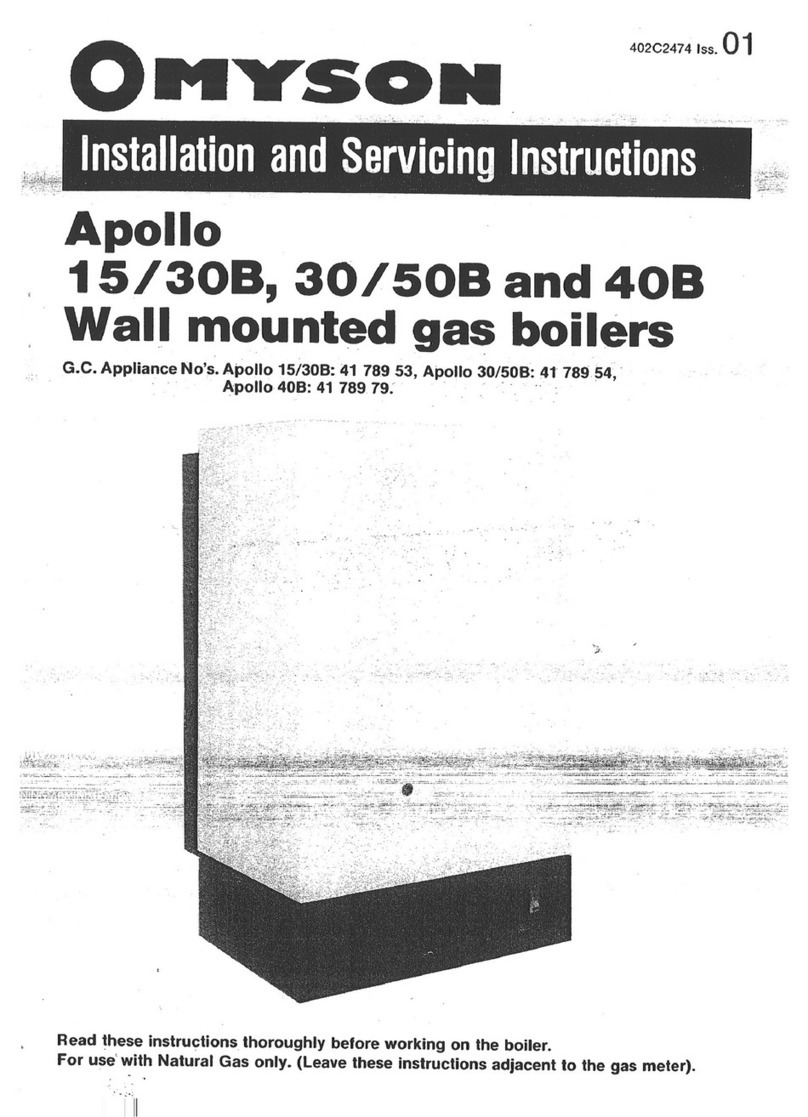
Omyson
Omyson Apollo 15/50B Installation and servicing instructions
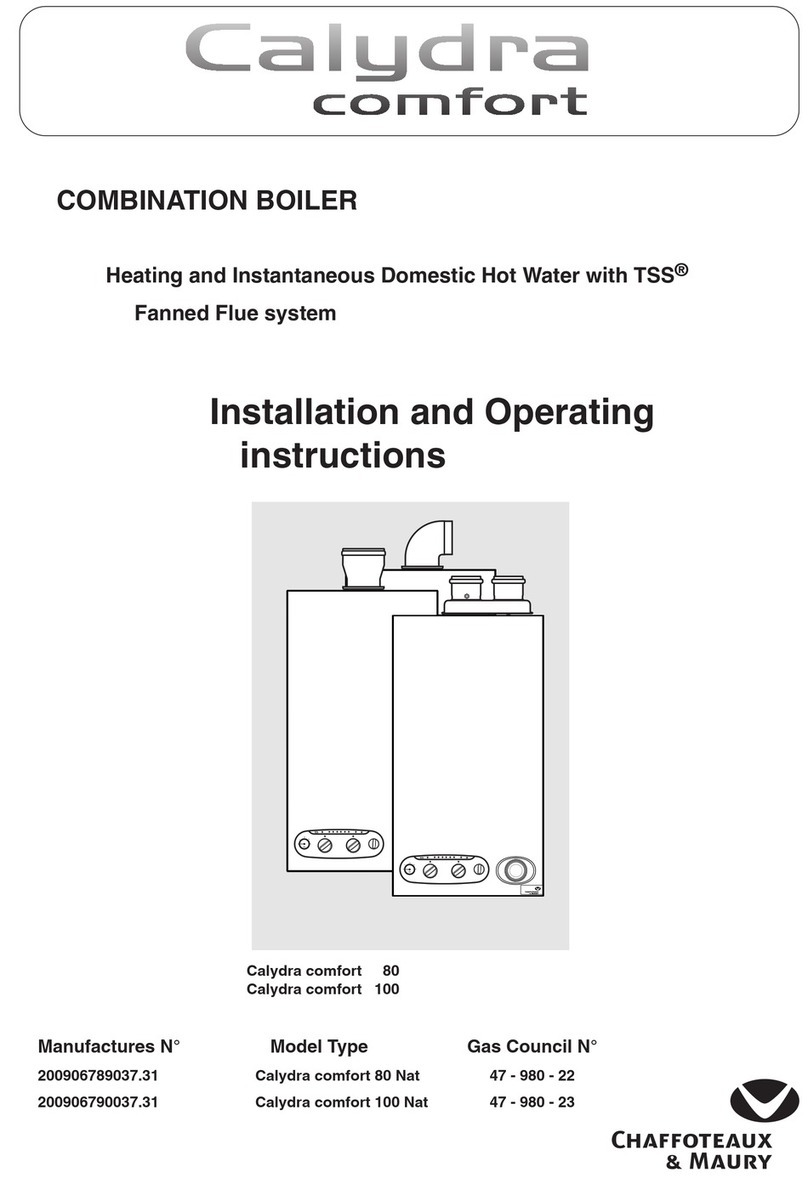
Chaffoteaux & Maury
Chaffoteaux & Maury Calydra comfort 80 Installation and operating instructions
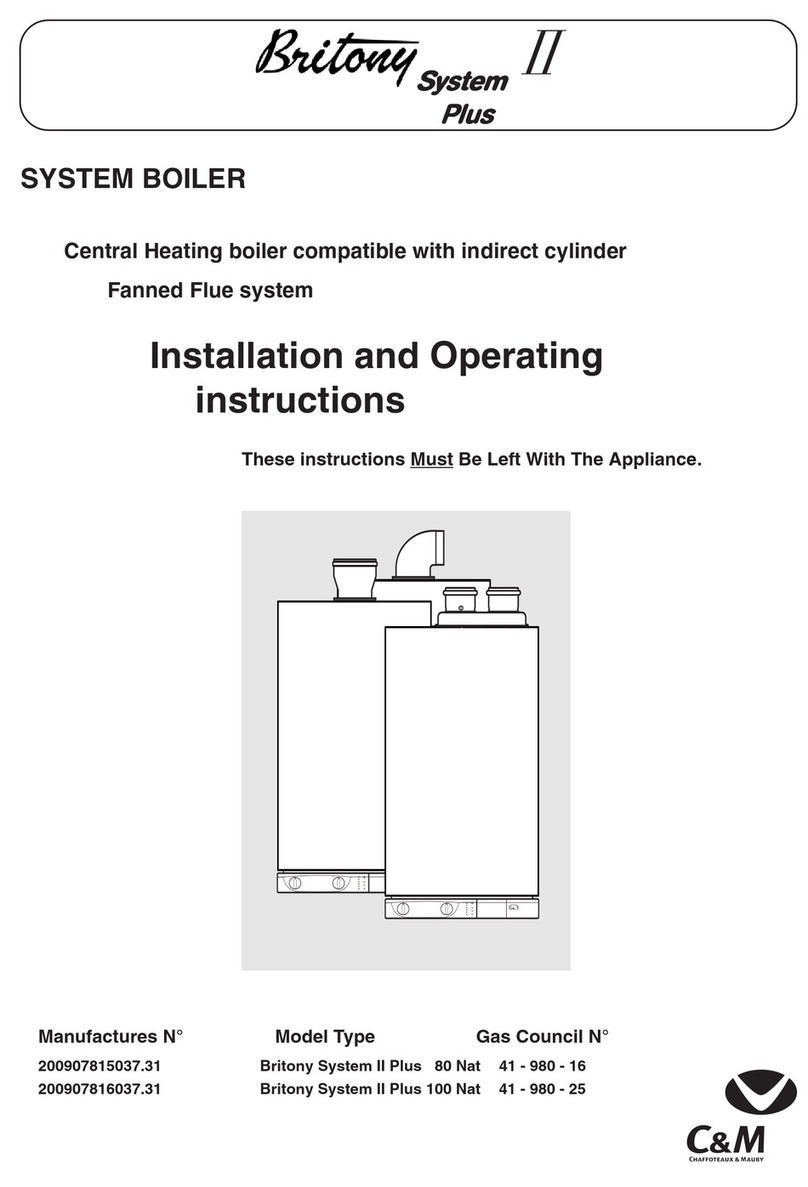
C&M
C&M Britony System II Plus 80 Nat instructions

IDEAL
IDEAL IMAX XTRA EL 320 user guide



